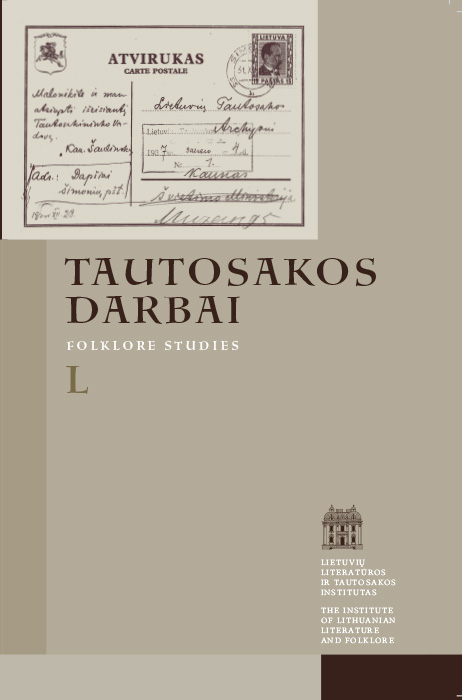Riddles on Writing, Linked together by the Image of Field
Abstract
The subject of the article is typology, genesis and semantics of the popular riddles on writing Balta dirva, juoda sėkla [‘White soil, black seed’] and Baltos lankos, juodos avys [‘White pasture, black sheep’]. For encoding various phenomena related to writing, the riddles frequently choose the visual graphic aspect of “the black on white” as the chief attribute and the core of the artistic image. This contrast is so suggestive and overshadowing all the other visual aspects that along with similar answers it is the main reason why even the riddles based on rather differing images like the above-mentioned ones are perceived in the international literature as mere variations or local adaptations of the same theme. The second riddle is even considered a variation of the first one, typical to the Eastern Europe and countries lying further to the East of it. The author of the article maintains a different approach, considering these riddles to be of different origins and possessing dissimilar imagery, but having identical answers, corresponding structures and similar beginnings: i.e. some kind of field, covering such semantic varieties as ploughed field – soil and grassy field – meadow, or pasture.
The first riddle in question Baltas laukas / balta dirva / žemė, juoda sėkla / juodi grūdai [‘White field / white soil / land, black seed / black grain’] could have come to Lithuania along with Christianity, because that is how its referent – writing – appeared. Its earliest recording from 1690 (published in 1744 by Theodor Lepner) did not mention colors: it talked only of venerable soil and wonderful seed. The oldest available Lithuanian variant of the second riddle Baltas laukas / baltos lankos / pievos, juodos avys [‘White field / white pastures / meadows, black sheep’] was published by August Schleicher in 1857: Lygios lankos, Pilkos avys, Piemenėlio už ausų botagėlis [‘Smooth meadows, grey sheep, the shepherd has a little whip behind his ears’]. It seems more akin to the question part of the riddle with numerous answers Laukas nematuotas, avys neskaitytos, piemuo raguotas (Dangus, žvaigždės, mėnuo) [‘The field is unmeasured, the sheep are uncounted, the shepherd is with horns (Sky, stars, and moon)’] than to the answer describing the ploughed land and seed. In addition, there are cases of riddling the sky and its visible objects as a meadow and animals too. Considering the close connections with Christianity and the great frequency of the metaphoric image of the priest as shepherd and his parishioners as sheep, it seems reasonable to suggest that images used in the riddles dealing with one sacred sphere – the sky – could have been transferred to describe the newly emerged other sacred things that could also point the way to the kingdom of heaven. The earliest known variant of the most popular riddle with white meadows and black sheep is the one published by Jonas Basanavičius in 1887: Balta pieva, juodos avys, kas išmano, tas jas gano [‘The white meadow, the black sheep, whoever is smart enough, shepherds them’]. Currently the corpus of Lithuanian riddles contains much more numerous recordings with “black sheep” than those with “black seed”, so the suggestion of the “sheep” riddle to be but a variation of the “seed” one can hardly be reasonable. Most probably, it is a separate riddle, a crossbreed between the archaic riddles on the sky bodies and the ones on writing depicting the black seed, and equally related to both. The unmeasured field, the blue meadow or smooth pastures readily gave way to the vivid and memorable contrast between white and black, adopted from the riddle talking of the same referent. The words išmintingas [‘wise’] and retas, ne bet kuris [‘rare, not common’] that were formerly used in the riddle with “soil” and “seed”, were replaced with the semantically close phrase kas išmano [‘whoever is smart enough’] because it rhymed with gano [‘shepherds’]. This entirely corresponded both to the tendency of rhyming the same parts of speech and their forms, syntactically symmetric phrases and sentences, which is characteristic to the riddle poetics in general, and to the high appreciation of literacy, which is universally declared not only in riddles, but in the folklore as a whole. The popularity of this version was significantly enhanced by its unobtrusive, yet obvious didactics: it very much suited the purposes of schooling. Interestingly enough, in the contemporary Lithuanian usage both the riddles in question seem to differentiate between the literacy-related actions: the one depicting ploughing and seed is rather more engaged with writing, while the one on shepherding – with reading. Yet in the case of the earliest Lithuanian recordings and others that do not harbour riddles with animals, one question of the riddle is likely to link together the images of both actions.
Downloads
Most read articles by the same author(s)
- Aelita Kensminienė, Contemporary Usage of Riddles in Lithuania , Tautosakos darbai: Vol. 64 (2022)
- Aelita Kensminienė, Lithuanian Riddles of the Pot as Allegories of the Human Life , Tautosakos darbai: Vol. 61 (2021)
- Aelita Kensminienė, Riddle of the Talking Quill: Wandering Motives , Tautosakos darbai: Vol. 58 (2019)
- Aelita Kensminienė, Shifting Perception of Riddles: from Reflection in Traditional Riddles to Metaphorical Washing-out of the Term in Mass Media. , Tautosakos darbai: Vol. 54 (2017)
